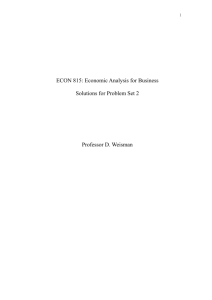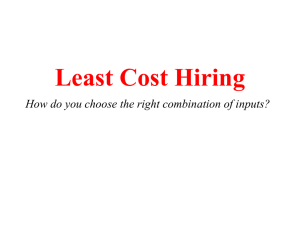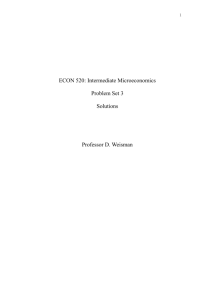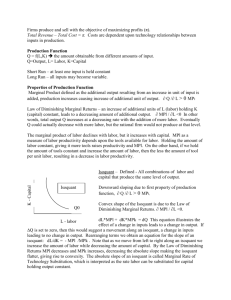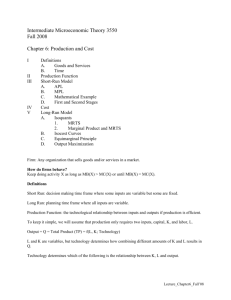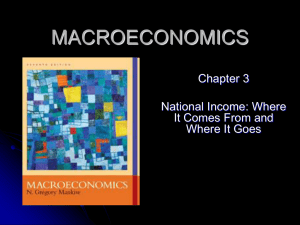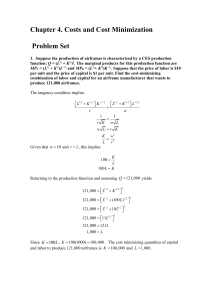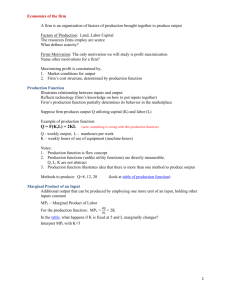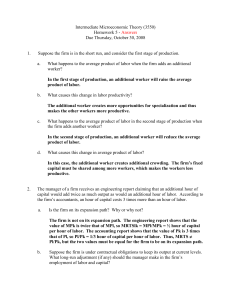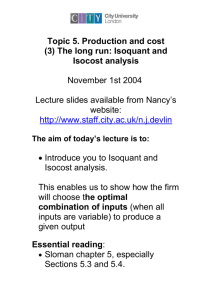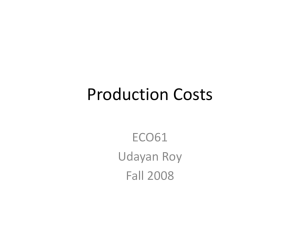Types of Costs Example: Types of Costs
advertisement
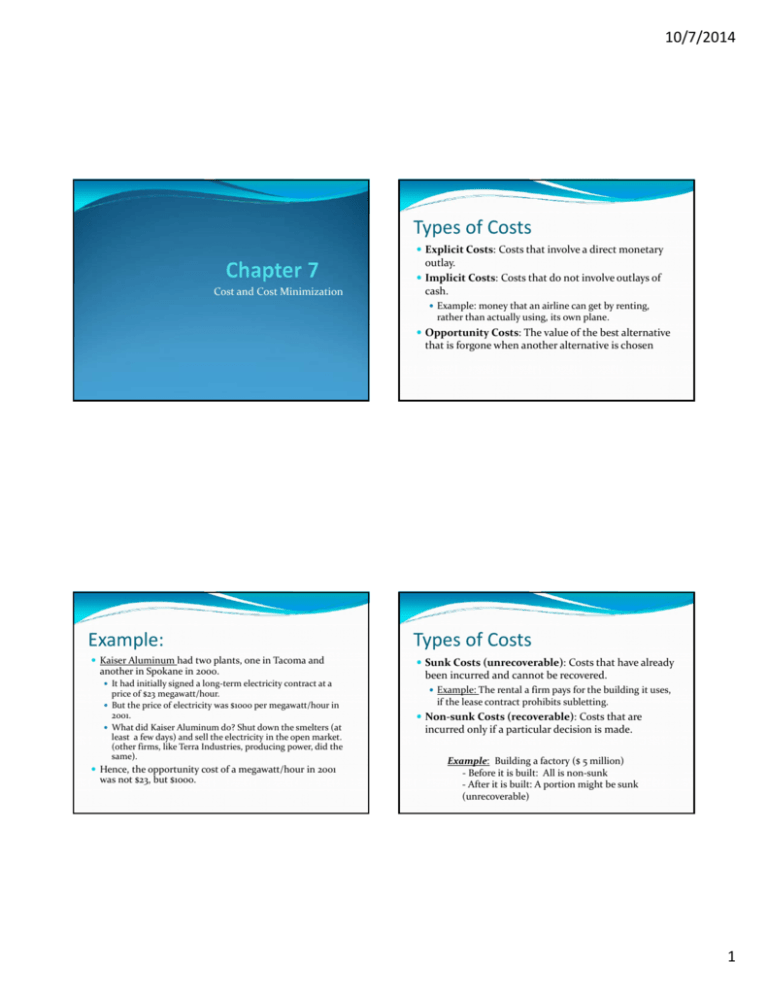
10/7/2014
Types of Costs
Explicit Costs: Costs that involve a direct monetary outlay.
Implicit Costs: Costs that do not involve outlays of Cost and Cost Minimization
cash. Example: money that an airline can get by renting, rather than actually using, its own plane. Opportunity Costs: The value of the best alternative that is forgone when another alternative is chosen
Example:
Kaiser Aluminum had two plants, one in Tacoma and another in Spokane in 2000. It had initially signed a long‐term electricity contract at a price of $23 megawatt/hour. But the price of electricity was $1000 per megawatt/hour in 2001. What did Kaiser Aluminum do? Shut down the smelters (at least a few days) and sell the electricity in the open market. (other firms, like Terra Industries, producing power, did the same).
Hence, the opportunity cost of a megawatt/hour in 2001 was not $23, but $1000.
Types of Costs
Sunk Costs (unrecoverable): Costs that have already been incurred and cannot be recovered.
Example: The rental a firm pays for the building it uses, if the lease contract prohibits subletting.
Non‐sunk Costs (recoverable): Costs that are incurred only if a particular decision is made. Example: Building a factory ($ 5 million)
‐ Before it is built: All is non‐sunk
‐ After it is built: A portion might be sunk (unrecoverable)
1
10/7/2014
Falling into the “Sunk Cost Fallacy” – Application 7.3
Consider the following condition A:
Condition A – you paid $10.95 to see a movie (or Pay TV.)
After 5 minutes, you are bored and the movie seems pretty bad
How much time do you keep watching the movie?
• 0 min, 10, 20, 30, until the end of the movie.
Experiment with/without A:
Cost Minimization
Long Run: The period of time that is long enough for the firm to vary the quantities of all its inputs as much as it desires.
Short Run: The period of time in which at least one of the firm’s quantities cannot be changed.
Example:
Senior citizens: Same amount of time with/without A
1) Restaurant: L is variable, K is fixed
2) Scientific lab: L is fixed, K is variable
College Students: More time with A than without, so they fell into “sunk cost fallacy” treating the $10.95 as
a non‐sunk cost, while it was already sunk
Short‐run costs ‐ Cheat sheet
Variable and nonsunk:
1.
ΔQ costs
Variable
But if Q = 0, then costs = 0
Nonsunk
Example: labor and raw materials
Fixed and nonsunk:
2.
∆Q no change in costs.
But if Q = 0 then costs = 0
Example: Heating
Fixed
Nonsunk
Fixed and sunk:
3.
∆Q no change in costs
Fixed
But if Q = 0 then costs>0
Sunk
Example: mortgage payment
Lease that cannot be sublet
Cost Minimization –
2 ingredients: Isocost and Isoquant.
Isocost line: The set of combinations of labor and capital that yield the same total cost for the firm
TC=wL + rK
where w: price of labor (wage)
r: price of capital (interest rate) Example: TC0 1000
Then,
TC1 2000
TC2 3000
TC0 1000
50 (vertical intercept)
r
20
TC0 1000
100 (horizontal intercept)
w
10
w=10
r=20
2
10/7/2014
More on the Isocost line…
TC = wL + rK
Since K is the vertical axis, we solve for K to obtain TC‐
wL=rK, or, w
TC
LK
r
r
TC
where denotes the vertical intercept of the Isocost r
line, and
w denotes the slope of the isocost line.
r
Example (cont.)
TC
0
1000 , w 10, r 20 implies an
Cost Minimization
We want to minimize TC reaching a given output (isoquant).
This is graphically represented by pushing the isocost
line downwards until it reaches the isoquant representing the output we must be producing, Q0. Points E and F also Q0
produce output , but at a higher cost TC 1
isocost line of
K
1000
10
r 50 . 5 r
20
20
Cost Minimization
To find the tangency point (point A)
Slope of isoquant=slope of isocost
line w
MRTS
Cost‐minimization Problem
Reach a given output q f (L,K), where q Q0
Min wL+rK minimize isocost line.
L,K
Subject to q f (L ,K ) is o q u a n t
L,K
r
MPL w
MPL MP K
MPK r
w
r
( L, K ; ) wL rK q ( L, K )
F.O.C.s
Additional output per dollar spent on labor = additional output per dollar spent on capital
At Point E: Slope of isoquant < Slope of isocost
MPL
w
MPL w
MPL MPk
MPK
r
MPk r
w
r
(Hence, increasing labor is still optimal)
w
f
0
w
}
L
MPL
߲L
f
r
r
0
K
K
MPK
w
r
w MPL
MPL MPK
r MPK
Tangency between the Isocost line and the Isoquant!
q f ( L, K ) 0 q f ( L , K )
3
10/7/2014
Example
We now have a system of two equations with two unknowns:
Production function Q 50 L K
K
L
Hence, MPL 25
and MPk 25
L
K
Input prices are w $5 and r $20.
4K L
400
L
K
a) What is the cost‐minimizing combination of L and K that reaches an output
Of Q 0 1000 units?
1/ 2
Tangency:
MP L
w
MP K
r
Not Done Yet!
K
K
L L
L
L
25
K
K
K
5
L
20
25
K
5
20 K 5 L
L
20
1/ 2
1/ 2
K K
1/ 2
L1 / 2 L1 / 2
}
4K
400
K 2 100 K 10
K
If we plug K*=10 into L=4K, we obtain the optimal value of L,
L 4 K 4 10 40 L 40
w
r
Hence, the cost‐minimizing combination of inputs is:
4k=L
K 10 and L 40
We also know that the cost‐minimizing combination of L and K must lie
Q 0 1000
on the isoquant , that is,
1000 50 L K 20 L K 400 L K
400
L
K
Query #1
A firm has a Cobb‐Douglas production function for its inputs of capital and labor. The firm is currently paying $10 per labor hour and $5 per machine hour. The firm is currently at an efficient production level, employing an equal number of machines and workers. What can we infer about the marginal productivities of capital and labor at this point?
a) MPK = MPL
b) MPK = 2MPL
c) MPL = 2MPK
d) MPL = .5MPK
Query #1 ‐ Answer
Answer C
The cost‐minimizing condition:
‐MRTSL,K = ‐MPL / MPK
MPL / MPK = (w/r)
Input prices: w = $10 and r = $5
So, the tangency condition for cost‐minimization entails
MPL / MPK = ($10/$5)
Cross multiplying, we obtain
5(MPL) = 10(MPK)
Simplifying,
MPL = 2MPK
Pages 236‐238
4
10/7/2014
Example of Corner solutions:
Corner Point Problem
Pr oduction Function :Q 10 L 2 K
Where MP L 10 and MPk 2
Here, the optimal solution doesn’t have a tangency between an isocost line and an isoquant curve.
Corner solutions arise when inputs are perfect substitutes, i.e., Q=aL+bK
Using the previous figure we observed that the optimal combination is a corner solution. Isocost line is flatter than the Isoquant:
Pr ice of labor :w 5 per unit
Pr ice of capital : r 2 per unit
Firm wish to produce :Q 200 units
MPL
w
MPK
r
rearranging:
MP L
w
MP L
MP K
MP K
r
w
r
which implies the firm wants
to use labor alone
MPL w
10 5
Why? Because , that is
MP
r
2
K
2
Alternatively, note that MPL 10 2 MPK 2 1
w
5
r
2
So that the marginal product per dollar of labor exceeds the marginal product per dollar of capital (2>1) , then the firm will substitute labor per capital until it uses no capital (K=0).
In the horizontal axis of the above figure.
Query #2
Then, the quantity of labor must satisfy Q= 10L + 2K, where we know K = 0 then…
reaching the isoquant Q=200 units implies 200=10L+2x0, or 200=10L
200 10L L
200
L 20
10
Summarizing, the firm uses L = 20 workers and K = 0 units of capital. (corner point)
Suppose in a particular production process that capital and labor are perfect substitutes so that three units of labor are equivalent to one unit of capital. If the price of capital is $4 per unit and the price of labor is $1 per unit, the firm should
a) employ capital only.
b) employ labor only.
c) use three times as much capital as labor.
d) use three times as much labor as capital.
5
10/7/2014
Query #2 ‐ Answer
Answer B
In this particular case, we have a corner point solution. The price of labor is $1/Unit, while that of capital is $4/ Unit.
In addition, we are informed that three units of labor, 3L, are equivalent to one unit of capital, i.e., 3L=K
Because these inputs are perfect substitutes, this firm can minimize its cost by spending $3/Unit on labor rather than spending $4 / Unit on capital. (Remember that 3 Units of Labor was equal to 1 Unit of Capital) Pages 238‐239
An Increase in Wages
An increase in the price of labor (Δw) produces an inward pivoting of the isocost line (steeper isocost
line)
But the firm must still reach Q=100 units!
They’d better incur larger TC! (shift isocost outward)
Comparative statics: An increase in wages Δw
1.
An increase in wages from w1
to w2, pivots the isocost line inwards, from C1 to C2.
2.
To still reach isoquant Q0, the firm cannot keep spending TC0, it must incur a larger cost TC1>TC0. (Parallel shift of the isocost line outwards, from C2 to C3).
A increase in w, when the Cost‐minimizing pair
was at a kink (L , K )
No change in the combination of L and K before/after the w
Comparing A and B: Then the cost‐minimizing amount of labor must go down ( L) and the cost‐minimizing quantity of capital must go up (K), from point A to B.
6
10/7/2014
Query #3
Query #3 ‐ Answer
Suppose capital and labor are perfect complements for a particular production process. If the price of labor increases, holding the price of capital and the level of output constant, the firm should
a) use more capital and less labor. b) use more labor and less capital.
c) use the same amounts of capital and labor. d) eliminate all use of labor.
Answer C
Comparative Statics‐ (2) change in “reachable” output
This firm has a fixed‐proportions production function, Q=min{aK,bL}.
Hence, inputs are used in specific ratios, and An increase in the price of labor does not cause the firm to substitute capital for labor.
If the price of capital and the level of output are held constant, the firm would continue to use the same amount of both labor and capital. Pages 240‐241
Comparative Statics‐ (2) change in “reachable” output
Expansion Path: A line that connects the cost‐
minimizing input combinations of (L,K) as the quantity of output, Q increases, holding input prices constant. Normal input: An input whose cost‐minimizing quantity increases as the firm produces more output.
inputs
The firm’s expansion path will have a positive slope.
Inferior input: An input whose cost‐minimizing ΔQ in L and K
ΔQ ΔK, but L (inferior input)
quantity decreases as the firm produces more output.
The firm’s expansion path will have a negative slope.
7
10/7/2014
Can both inputs be inferior? NO!
Labor Demand Curve
Labor Demand Curve : A curve that shows how the firm’s cost minimizing quantity of labor varies with the price of labor.
1)
Labor Demand
2) When we increase output from Q= 100 & Q=200, If Ldem shifts outward, Cost‐minimizing input combination varies from A to C in the top figure, which implies a shift from A’ to C’ in the bottom figure
ΔW from w=$1 (at A) to w=$2 (at B), labor usage decreases. This is depicted in A and B, respectively, in the top figure, and A’ and B’ in the bottom figure of labor demand for Q=100.
Can Labor demand be vertical?
•Yes,
•When both inputs are used in fixed proportions, we saw that wage changes don’t affect the cost‐minimizing input combination.
(Remember the figure of right‐angled isoquants?).
•Hence, labor demand would be insensitive to wages:
then L is a normal input (as depicted in the figure). If Ldem shifts inwards, then L is an inferior input. Price of labor in A’
and C’ is the same, we only change output from Q=100 to Q=200
8
10/7/2014
Finding the Labor Demand Algebraically
•Consider a Cobb‐Douglas production function Q 50 LK
•From the tangency condition between isoquant and isocost, we obtain MP w
l
MPK r
Q
MPL L (0.5)(50) LKK K
or
MPK Q (0.5)(50) LK L L
K
MP L
w
Hence ,
implies
MP K
r
Q 50 LK
w
K
or solving
L
r
for L, L
Q w
r
Plugging the above result, K
into L K
50 r
w
L
r
L K
Plugging the above expression, , into the w
production function we obtain Q 50 LK
Q 50
r
Q
Q
Q w
r
r
KK
K2
KK
w
50
50
50 r
w
w
L
We just found the demand curve for capital, i.e. “capital demand.” r
K
w
Finding Labor Demand Algebraically
Finding Labor Demand Algebraically r Q w
r w Q
Q r
L
L
w 50 r
50 w
r w 50
K
which describes the demand curve for capital, i.e., the “labor demand.”
Finding Labor Demand Algebraically Note that:
Q w
K
1) Capital demand, , is…
50 r
Decreasing in r
Increasing in w
Increasing in Q
Q r
2) Labor demand, , is…
L
50 w
Increasing in r
Decreasing in w
Increasing in Q
Since an ΔQ produces an increase in the demand of both K and L, both inputs are normal (not inferior). 9
10/7/2014
Price Elasticity of Demand for Labor: The percentage change in the cost‐minimizing quantity of labor with respect to a 1 percent change in the price of labor.
L ,w
The price elasticity of the demand for labor depends on the elasticity of substitution, σ between two inputs (K and L):
CES with
=.25
from Ch. 6
CES with
=2
L
L
* 100 %
L w
L
L
w
w
w L
* 100 %
w
w
1% in w ages in the firm 's labor dem and of L,W %
W
Δ
Δ
Hence, it depends on the slope of the demand W
curve for labor.
L L
or
measures such slope
W K
In both cases w drops from $2 to $1 (a 50% drop), but…
Increase in labor demand in figure (a), 5 4.6
8% and labor only increases from 4.6 to 5.
4.6
5 2.2
127% Increase in labor demand in figure (b), 2.2
and labor increases a lot: from 2.2 to 5.
A change in w has almost no effect on L
The same change in w
induces a great change in L
Similarly for the price elasticity of the demand for capital:
K
K r
K
r
r
r K
*100%
r
r
K
k ,r K
*100%
Interpretation:
1% in interest rates (r) inthe firm's labor demandfor capitalof a of K,r %
It depends on the slope of the demand curve for capital,
K K
r
r
10
10/7/2014
Price elasticities of input demand for manufacturing industries in Alabama
Nonproduction
Labor
Cost Minimization in the Short Run
Capital
Production Labor
Textiles
‐0.41
‐0.50
‐1.04
‐0.11
Paper
‐0.29
‐0.62
‐0.97
‐0.16
Chemicals
0.12
‐0.075
‐0.69
‐0.25
Metals
‐0.91
‐0.41
‐0.44
‐0.69
Consider the textile industry (first row):
The ‐0.50 in the second cell implies that a 1% increase in the wage rate for production workers only entails a 0.5% decrease in the demand for labor of the typical textile firm in Alabama. (Labor demand is rather insensitive to labor).
All but one of the price elasticities of input demand are between 0 and ‐1, suggesting that industries do not aggressively reduce their demand of the input whose price became relatively more expensive.
Cost Minimization in the Short Run
Example: consider the Cobb‐Douglas production function Q 50 LK
K
If K is fixed at in the short run, then the cost‐
minimizing L is found by solving for L,
Q
Q2
2,500 K
This is the demand for labor in the short run, where K is fixed.
Q 2 50 LK
2
2
•In the long‐run the firm modifies L and K in order to reach Q0. •Solution: Point A
Electricity
2,500 LK L
K K
•In the Short run K is fixed at •If the firm must reach output level of Q0, it must use F, incurring a larger cost, i.e., a higher isocost. Fixed Capital
Three inputs – Learning by Doing 7.6
Consider the Cobb‐Douglass production function Q L K M , where L denotes labor, K capital, and M raw materials. Hence, the marginal products are:
1
1
1
MPL
MPk
MPM
2 L
2 K
2 M
Assume that input prices are w=1, r=1, m=1
a) If the firm wants to produce Q=12, what is the cost‐minimizing input combination L*, K*, M*?
MPL w
1/ 2 L 1
K
1 K L
MPK r
L
1/ 2 K 1
K=L=M
Extra practice: Learning‐by‐Doing exercise 7.6 (3 inputs).
We go over this exercise next. MPL w
1/ 2 L 1
M
1 M L
MPM m 1 / 2 M 1
L
11
10/7/2014
K 4
b) If capital is fixed at 4 units, i.e., units, what is the cost‐minimizing input combination (L*,M*)?
Using K=L=M in the production function yields:
12 L L L 12 3 L
K=L
12
L 4 L
3
16 L
M=L
MPL
w
1/ 2 L 1
M
1 M L
MPM m
L
1/ 2 M 1
Plugging that information into the production function, we obtain:
12
L 5 L
2
25 L
12 L 4 L 10 2 L
Therefore, L=16, which entails that K=16 and M=16
K=4 (fixed)
M=L
Hence, since L=25, then M=25, while the fixed amount of capital K 4
remains .
c) What if now we fix the amount of capital at , and the K 4
amount of labor at workers?
L9
12 9 4 M
L9
K
Summary of the Cost‐Minimization Problem with 3 Inputs
12 3 2 M
Labor, L
Capital, K
Materials, M
Minimized Total Cost
Long‐run cost minimization for Q=12
16
16
16
$48
Short‐run cost minimization for Q=12 when K=4
25
4
25
$54
Short‐run cost minimization for Q=12 when K=4 and L=9
9
4
49
$62
7 M 49 M
4
Hence, M=49, while the two other fixed inputs remain at K 4
and .
L9
12
